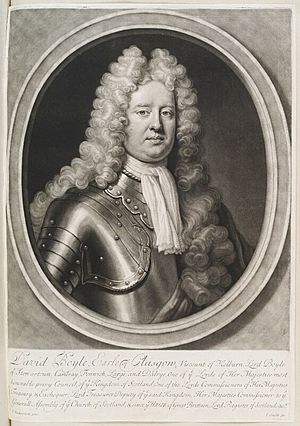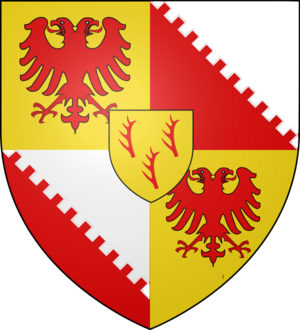David Boyle, 1st Earl of Glasgow facts for kids
David Boyle, 1st Earl of Glasgow (around 1666 – 31 October 1733), was an important Scottish politician and a noble. He held the title of Treasurer-depute just before Scotland and England joined together to form Great Britain.
Quick facts for kids
The Earl of Glasgow
|
|
|---|---|

1711 engraving of the Earl by John Smith based upon a Jonathan Richardson portrait
|
|
| Scottish Representative Peer in the House of Lords |
|
| In office 13 February 1707 – 21 September 1710 |
|
| Preceded by | Established |
| Commissioner of the Parliament of Scotland for Bute |
|
| In office 1689–1699 |
|
| Preceded by | James Stuart, 1st Earl of Bute |
| Succeeded by | William Stewart |
| Rector of the University of Glasgow | |
| In office 1690–1691 |
|
| Preceded by | Robert Ramsay |
| Succeeded by | Sir John Maxwell |
| Personal details | |
| Born |
David Boyle, esq.
c. 1666 Kelburn Castle, Fairlie, North Ayrshire, Scotland |
| Died | 31 October 1733 Fairlie, North Ayrshire |
| Spouses |
Margaret Lindsay-Crawford
(m. 1687; Jean Mure
(m. 1697; |
| Children | John Boyle, 2nd Earl of Glasgow Lady Jean Boyle Mure |
| Parents | John Boyle Marion Steuart |
| Occupation | Politician |
Contents
Early Life of David Boyle
David Boyle was born around 1666. His birthplace was Kelburn Castle in Fairlie, Scotland. His father was John Boyle of Kelburn. His mother was Marion Steuart.
David Boyle's Career
From 1689 to 1699, David Boyle served as a Commissioner for the Bute area. This meant he represented Bute in the Parliament of Scotland. In 1697, he became a Privy Counsellor. This was a special advisor to the King or Queen.
He was also the Rector of the University of Glasgow from 1690 to 1691. Before Scotland and England united, he was the last Treasurer-depute. This role was like a deputy treasurer for the country.
The Union of Scotland and England
David Boyle strongly supported the Acts of Union. These laws joined Scotland and England into one country called Great Britain. After the Union, he became a Scottish representative peer. This meant he represented Scotland in the new British Parliament, called the House of Lords. He served there from 1707 to 1710.
Many people in Scotland hoped the Union would help their country. Scotland had faced a big financial problem. This was due to a failed plan called the Darien scheme. In this plan, Scotland tried to set up a trading colony in Panama. It lost a lot of money.
The Union promised financial help from England. It also lifted some unfair laws, like the Alien Act. This act had been put in place to pressure the Scottish Parliament.
As part of the Union, Scotland received a large sum of money. This money was called The Equivalent. It was meant to help Scotland with its debts. It also compensated people who lost money in the Darien scheme. David Boyle and the Duke of Queensbury received a significant part of this money.
Other Important Roles
David Boyle also held other important positions. He was appointed Lord High Commissioner to the General Assembly of the Church of Scotland. He served in this role in 1706, and again from 1707 to 1710. This role involved representing the King or Queen at the Church's main meeting. He was also the Lord Clerk Register before 1714. This was a high legal position in Scotland.
Becoming a Noble
On 31 January 1699, David Boyle became a noble. He was given the title Lord Boyle of Kelburn. This was part of the Peerage of Scotland. Later, on 12 April 1703, he received even higher titles. He became the Viscount of Kelburn and the Earl of Glasgow. These titles could be passed down to his male heirs.
David Boyle's Family Life
David Boyle married twice. His first wife was Margaret Lindsay-Crawford. They married on 19 April 1687. Margaret passed away in 1695.
Together, they had several children:
- John Boyle, 2nd Earl of Glasgow (1688–1740). He later became the 2nd Earl of Glasgow.
- Patrick Boyle, Lord Shewalton (died 1761).
- Charles Boyle (1691/92–1770). He traveled to America and later returned to England.
David Boyle married his second wife, Jean Mure, on 16 June 1697. Jean passed away in 1724. They had three daughters. One of their daughters was:
- Lady Jean Boyle Mure of Rowallan (died 1729). She married Sir James Campbell in 1720.
In 1711, a famous engraving of David Boyle was made. It was created by John Smith. The engraving was based on a portrait painted by Jonathan Richardson.
His Descendants
David Boyle's eldest son, John, became the 2nd Earl of Glasgow. John's son, John Boyle, 3rd Earl of Glasgow (1714–1775), became the 3rd Earl in 1740.
Another of David Boyle's grandsons was James Mure Campbell (1726–1786). He later became the 5th Earl of Loudoun. James had a daughter named Flora Mure-Campbell (1780–1840). She became the 6th Countess of Loudoun.
Images for kids




